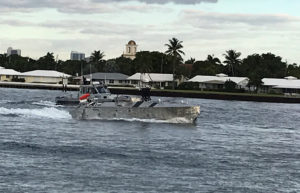A Navy official this week confirmed the service has addressed reliability issues in the Unmanned Influence Sweep System (UISS) that were tied to vehicle design issues identified in the latest annual report from the Pentagon’s top weapons tester.
The UISS is part of the Littoral Combat Ships (LCS) mine countermeasure (MCM) mission package, currently set to be posted to Independence
-class LCSs. The UISS and the AN/AQS-20C towed mine hunting sonar are the surface elements of the MCM package, towed from an MCM Unmanned Surface Vehicle (USV). Other elements include the Knifefish minehunting unmanned underwater vehicle, and systems based on the MH-60S helicopter and MQ-8 Fire Scout unmanned helicopter.

The MCM mission packages seek to replace legacy Avenger-class Mine Countermeasures Ships.
The Director of Operational Test and Evaluation (DOT&E) annual report released on Jan. 20 said the UISS is not operationally suitable, with reliability and availability not supporting sustained minesweeping operations.
“Operational availability demonstrated when employing UISS from an LCS was 0.29, well below the Navy defined minimum threshold,” the report said.
The report listed an August 2022 operation test event, which had the full LCS MCM mission package, which included integrating UISS.
The Navy declared Initial Operating Capability (IOC) the previous month, the first time the service reached IOC on a USV. IOC marked the completion of formal testing and delivered the system with logistics and training material allowing the fleet to conduct minesweeping via the mission package (Defense Daily, July 29, 2022).
Rear Adm. Casey Moton, Program Executive Officer for Unmanned and Small Combatants, admitted to reporters the Navy knew about these reliability issues when it conducted earlier UISS operational testing in May and June 2021.
“So UISS, during its testing it did have some suitability challenges like DOT&E reported on that,” Moton said Monday during the American Society of Naval Engineers’ Technology, Systems and Ships Symposium.
After the operational testing, the Navy “aggressively looked at all of the issues that did pop up during” Initial Operational Test and Evaluation (IOT&E), briefed a corrective action plan for each, and made changes to the vessels allowing it to proceed to the IOC decision, he continued.
Moton said the Navy then demonstrated the reliability fixes at the IOT&E event last August, where they saw “a marked improvement. And we did not see any significant repeats of hits.”
He added the DOT&E’s report was a “fair look at IOT&E but we went after the fixes. And we were able to demonstrate that that was successful at the later mission package testing.”
Moton confirmed the issues were tied to the initial Textron [TXT] testing vehicles and engineering change proposals (ECP) fixes are being applied to the design of the Bollinger Shipyards-built full-rate production vessels.
“They were for the most part tied to vehicle design aspects. There were some procedural areas, there were some crew areas…so they were all aspects. So what we have done is not only fix the vehicle we tested, but we developed ECP packages for all of those fixes. And those fixes are being applied to the Bollinger vehicles at the start of the production line,” Moton said.
“So they’ve already been tested. And when the vehicles roll off the Bollinger line, they will have the ECPs,” he added.
In April, the Navy announced Bollinger beat Textron for the MCM USV full production contract that may rise to 24 vehicles total (Defense Daily, April 11, 2022).
The Navy initially awarded Textron contracts to build four Common Unmanned Surface Vessel (CUSV) vehicles used for Navy testing before conducting the competitive contract for full-rate production.
In August, Textron lost its protest bid with the Government Accountability Office (GAO). The GAO decision showed Bollinger’s bid for the contract was $107 million compared to Textron’s $158 million (Defense Daily, Aug. 11).